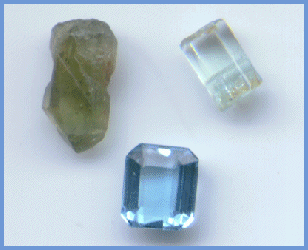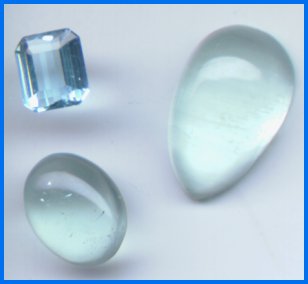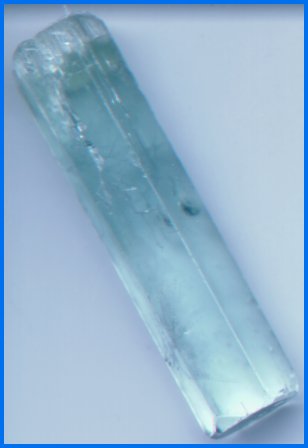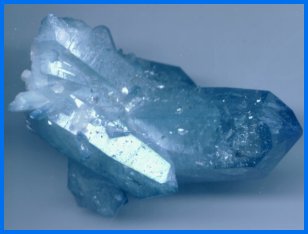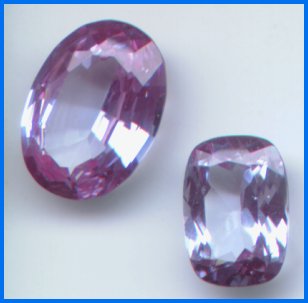Aquamarine has been the traditional birth stone for the month of March although some jeweler's charts list bloodstone as an alternate. Aquamarine ranges from pale blues to light blues to yellowish blues. Aquamarine is the mineral Beryl, a Beryllium Aluminum Silicate with the general chemical formula Be3Al2(Si16O18). Beryl crystallizes in the hexagonal system, it ranges in hardness from 7 1/2 to 8 on Moas scale; it has an imperfect cleavage and a vitreous luster. Optically, beryl is uniaxial negative; some specimens may be strongly diachronic; its refractive index ranges from about 1.57-1.58 or to 1.58-1.59.
Other beryl varieties that have been used for gems include emerald (blue green to green), goshenite (colorless), morganite (pink to violet), and heliodor or golden beryl. There is also a red beryl that comes from Utah.
Inclusions in aquamarine may include mica, hematite, liquid-filled (often salt-water) tubes and hoses. The liquid can expand considerably if the crystals become overheated, causing them to fracture badly, or in rare instances, to explode.
The name aquamarine has been used as a modifier for many other materials such as aquamarine tourmaline, aquamarine emerald, aquamarine chrysolite, aquamarine sapphire, aquamarine topaz, etc.
"Aquamarine Emerald" is a registered trade name that is used for a kind of triplet stone that has two layers of usually aquamarine or sometimes colorless beryl that are cemented together with a green cement to create the impression of a true emerald. This kind of stone might be difficult to detect by refractive index alone so magnification will help detect the squiggly flow lines of cement and immersing the stone in water will help detect the several layers that make it up.
Aquamarine glass is a term that is used for light blue to medium blue glass that may or may not include beryl as a constituent.
Aquamarine has also been used to describe the sea, the skies, some General Motors cars, or other pale to medium blue objects.
Old World sources of aquamarine include Madagascar, Russia, and Sri Lanka whereas New World sources include Brazil, Colorado, and North Carolina.
Aquamarine crystals are often elongated along the c-axis whereas emerald crystals are often blunted along the c-axis. This creates the effect of the former appearing wand-like or pencil-like whereas the latter may appear barrel-like.
Most gem beryl comes from a very coarse-grained rock that geologists call pegmatite. Pegmatite are formed late in the magmatic history of an igneous terrace and they represent the late stage vocatives that crystallize in hydrothermal deposits. Beryl crystals can often become quite large, some exceeding 25 feet or more in length along the c-axis.
Some aquamarines are chatoyant and can produce a nice eye. Asteriated aquamarines do not appear in any of the sources I have examined.
Most synthetic aquamarines are actually synthetic spinel. Flux-fusion processes yield a glass rather than a crystal when beryl is processed in them although the colors can be retained. Light blue is very difficult to produce in synthetic corundum. Some of the hydrothermal processes that are now available for synthesizing gems may yield decent synthetic aquamarines.
Aqua Aura is a registered trade name that provides an aquamarine substitute. It is produced by an essentially monomolecular thick coating of gold over a quartz crystal or other stone. The gold coating is achieved by vaporizing the gold in bell and allowing the gold to precipitate on the object to be coated. Such coatings are used when one is preparing micro- or nannofossils or micro crystals for imaging in a scanning electron microscope.
Because of a fairly low refractive index, aquamarine needs a fairly deep pavilion with angles of about 43o to assure maximum internal reflection. Too shallow a pavilion will cause the stone to appear empty and too deep a pavilion will cause the center to become dark. Best results are often obtained with an emeralds style cut to take advantage of the double refraction and low birefringence.
For Further Reading
- Schumann, W., 1977. Gemstones of the World. Sterling Publishing Co., New York, 256 p.
- Shirley, R. M., 1971. Dictionary of Gems and Geology. Geological Institute of America, Los Angeles, CA, 230 p.
- Sinkankas, J., 1959. Gemstones of North America. Van Nostrand Reinhold Company, New York, 675 p.
- Sinkankas, J., and Read, P. g., 1986. Beryl Butterworth Books, London, Boston, 225 p.
